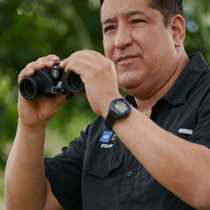Punta Vicente Roca & Fernandina Island
This day began with an extraordinary view of the huge volcanoes of Isabela Island in the distance. A great event took place; we had our official crossing of the Equator. Our junior explorers received signed certificates as proof that they became “shell backs” instead of the mere “pollywogs” by crossing from the northern hemisphere.
Later in the morning, we entered the calm bay of Punta Vicente Roca located in the southern hemisphere. We boarded our Zodiacs to explore the coastal cliffs of this volcano. In addition to being a geologist’s paradise, this area teems with wildlife of all kinds. Blue-footed boobies, Nazca boobies, Pacific sea turtles, Galápagos penguins and flightless cormorants, just to mention a few, were seen everywhere. Numerous seabirds, like the Brown Noddy Terns, were observed perching on the shelves that the wind has carved out of the soft material forming the colossal slopes of the adjacent tuff cones of this volcano.
Not far away from the coast we found the majestic and huge ocean sunfish (Mola mola), which happens to be one the largest bony fish species on earth! Just after the Zodiac ride, we headed to a snorkelling site full of marine life. To be able to swim with Pacific sea turtles and Galápagos sea lions is an unforgettable experience.
On this afternoon of our Galápagos cruise, we visited the island of Fernandina – its very active volcano known simply as “The Summit” is striking. Every single living creature on the island depends on this huge volcano. Numerous volcanic eruptions have occurred in the last centuries and are responsible of constantly shaping the landscape and creating new land that is shortly thereafter colonized. Visiting Fernandina Island is just like taking a trip back in time. For the most part, the island is formed of immense lava fields where hardly anything grows in this harsh environment. Very few plant species can survive in these harsh conditions. Some plants are so tough that can break the lava, like the fascinating endemic lava cactus (Brachycereus sp), which little by little erodes the hard basalt with their strong roots, until this plant became a dominant species. An octopus spotted on an intertidal pool was a sensation, and everybody wanted to see it at a close range.
Just minutes before sunset we returned to National Geographic Islander with our hearts filled with joy after spending a spectacular day in one of most pristine locations in the world.




